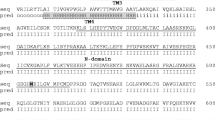Abstract
Binding of TNP-ATP [2′,3′-O-(2,4,6-trinitrophenyl)adenosine 5′-triphosphate, a fluorescent analogue of ATP] to the K605 protein was studied. This is an isolated N-domain in the cytoplasmic loop of the Na/K-ATPase α-subunit, lying between membrane-spanning segments 4 and 5 (sequence L354-I604). A titration equation is derived that explicitly makes it possible to relate the fluorescence of TNP-ATP and K605 solutions to total probe concentration in the sample. Using this, it is possible to obtain the value of the dissociation constant from the titration experiment without resorting to the Scatchard plot, which is far from optimal from the statistical point of view. Using the new formula with non-linear regression analysis, a value of the dissociation constant K D for TNP-ATP binding to the K605 protein of 3.03±0.28 μM at 22 °C was obtained. A series of fits to simulated data with added noise demonstrated clearly the advantage of non-linear regression using the new formula over the commonly employed linear regression using the Scatchard plot. The procedure presented is generally applicable to binding assays using changes in the fluorescence of ligands on binding.


Similar content being viewed by others
References
Bevington PR (1969) Data reduction and error analysis for the physical sciences. McGraw-Hill, New York
Bollag DM, Rozycki MD, Edelstein SJ (1996) Protein methods, 2nd edn. Wiley-Liss, New York
Deranleau DA (1969) Theory of the measurement of weak molecular complexes. I. General considerations. J Am Chem Soc 91:4044–4049
Gatto C, Wang AX, Kaplan JH (1998) The M4M5 cytoplasmic loop of the Na,K-ATPase, over expressed in Escherichia coli, binds nucleoside triphosphates with the same selectivity as the intact native protein. J Biol Chem 273:10578–10585
Hiratsuka T (1975) 2′(or 3′)-O-(2,4,6-trinitrophenyl)adenosine 5′-triphosphate as a probe for the binding site of heavy meromyosin ATPase. J Biochem (Tokyo) 78:1135–1147
Hiratsuka T (1976) Fluorescence properties of 2′(or 3′)-O-(2,4,6-trinitrophenyl)adenosine 5′ triphosphate and its use in the study of binding to heavy meromyosin ATPase. Biochim Biophys Acta 453:293–297
Hiratsuka T (1982) Biological activities and spectroscopic properties of chromophoric and fluorescent analogues of adenine nucleoside and nucleotides, 2′,3′-O-(2,4,6-trinitrocyclohexadienylidene)adenosine derivatives. Biochim Biophys Acta 719:509–517
Hiratsuka T, Uchida K (1973) Preparation and properties of 2′(or 3′)-O-(2,4,6-trinitrophenyl)adenosine 5′-triphosphate, an analogue of adenosine triphosphate. Biochim Biophys Acta 320:635–647
Hiratsuka T, Sakata I, Uchida K (1973) Synthesis and properties of N 6-(2,4-dinitrophenyl)adenosine 5′-triphosphate, an analogue of ATP. J Biochem (Tokyo) 74: 649–659
Hofbauerova K, Kopecky V Jr, Ettrich R, Ettrichova O, Amler E (2002) Secondary and tertiary structure of the nucleotide-binding domain of the α-subunit of Na+/K+-ATPase. Biopolymers 67:242–246
Johnson ML, Straume M (2000) Deriving complex ligand-binding formulas. Methods Enzymol 323:155–167
Leatherbarrow RJ (1990) Use of non-linear regression to analyze enzyme kinetic data: application to situations of substrate contamination and background subtraction. Anal Biochem 184:274–278
Leatherbarrow RJ (1991) Using linear and non-linear regression to fit biochemical data. Trends Biochem Sci 16:51–52
Lin M, Nielsen K J (1997) Binding of the Brucella abortus lipopolysaccharide O-chain fragment to a monoclonal antibody. Quantitative analysis by fluorescence quenching and polarization. J Biol Chem 272:2821–2827
Moczydlowski EG, Fortes PA (1981a) Characterization of 2′,3′-O-(2,4,6-trinitrocyclohexadienylidine)adenosine 5′-triphosphate as a fluorescent probe of the ATP site of sodium and potassium transport adenosine triphosphatase. Determination of nucleotide binding stoichiometry and ion-induced changes in affinity for ATP. J Biol Chem 256:2346–2356
Moczydlowski EG, Fortes PA (1981b) Inhibition of sodium and potassium adenosine triphosphatase by 2′,3′-O-(2,4,6-trinitrocyclohexadienylidene)adenine nucleotides. Implications for the structure and mechanism of the Na:K pump. J Biol Chem 256:2357–2366
Peters F, Pingoud A (1979) Numerical analysis of binding studies: a direct procedure avoiding the pitfalls of a Scatchard analysis of equilibrium data for unknown binding models. Int J Biomed Comput 10:401–415
Rodbard D, Munson PJ, Thakur AK (1980) Quantitative characterization of hormone receptors. Cancer 46:2907–2918
Acknowledgements
This work was supported by grant MSM113200001 from The Ministry of Education, Youth and Sports of the Czech Republic. We thank also Kateřina Hofbauerová and Jan Teisinger for helping with protein preparation, and Jiří Bok for his assistance in simulating titration data. We also wish to thank one of reviewers of this work for valuable comments.
Author information
Authors and Affiliations
Corresponding author
Appendix
Appendix
A: normalized fluorescence intensity
On multiplication of both sides by (γ−1)(F*−[L]T), Eq. (9) becomes:
hence the final quadratic equation:
is usefully obtained, leading to:
One can easily verify that it is the "minus square-root" alternative that satisfies the initial condition F*=0 for [L]T=0, as well as the result of titration experiments performed in the absence of protein, i.e., F*=[L]T for [P]T=0.
B: assessment of the γ factor
On substituting [P]T=0 into Eq. (A3), i.e., for protein-free samples, the normalized fluorescence intensity F* equates with the ligand concentration:
The other limiting situation can be reached with samples of very high protein concentration, such that [P]T>>K D. In the initial phase of a titration experiment performed with such a sample, when both [L]T and [PL] are very low compared to [P]T, the ratio of occupied binding sites is negligible, i.e. [P]≈[P]T. The equilibrium of Eq. (1) then leads to the following conclusion:
which is equivalent to the statement that practically all ligands are present in the bound form. The intensity of fluorescence from samples containing protein at high concentration is thus given by:
The value of the γ factor is thus obtained as the ratio of initial slopes in F* versus [P]T plots that have been obtained for a sample containing concentrated protein and no protein, respectively.
Rights and permissions
About this article
Cite this article
Kubala, M., Plášek, J. & Amler, E. Limitations in linearized analyses of binding equilibria: binding of TNP-ATP to the H4-H5 loop of Na/K-ATPase. Eur Biophys J 32, 363–369 (2003). https://doi.org/10.1007/s00249-003-0278-y
Received:
Revised:
Accepted:
Published:
Issue Date:
DOI: https://doi.org/10.1007/s00249-003-0278-y




